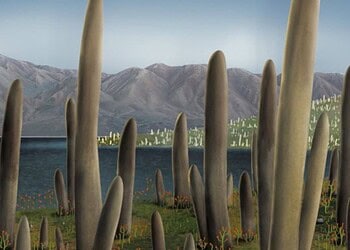
Researchers have successfully germinated a seed that lay dormant for over a millennium in the dry caves of the Judean Desert. Now, after 14 years of careful cultivation, that seed has grown into a unique tree that might just answer a Biblical riddle.
The plant is a previously unknown species of Commiphora. This tree, which researchers are calling “Sheba”, produces a resin with potential therapeutic properties, including anti-inflammatory and even anti-cancer benefits. This resin may, in fact, be the mysterious “tsori” resin mentioned in the Bible.
A Mysterious Tree with Healing Powers
The story of Sheba began in the late 1980s when archaeologists uncovered an ancient seed while excavating a cave in the Judean Desert. Radiocarbon dating suggests the seed was formed sometime between 993 and 1202 CE.
For decades, the seed remained untouched, until 2010 when a team of scientists decided to see if they could bring it back to life. It wasn’t an easy task. The seed, estimated to be over 1,000 years old, required a lot of special preparation and care. But it worked.

After five weeks, “Sheba” sprouted, revealing a specimen from the Commiphora genus—a group known for its gum-bearing trees. Only now, after nearly a decade and a half, has the tree reached a height of about 10 feet (3 meters). With the tree almost fully grown, scientists were able to extract its DNA and perform chemical tests.
Commiphora species are famed for producing aromatic resins like myrrh and frankincense. However, this particular seedling is unlike any species cataloged before. According to the researchers, DNA analysis places it in a clade with three species native to southern Africa. However, “Sheba” remains unique, with no close relation to the commercially harvested Commiphora species such as C. gileadensis, which is often associated with the famed biblical “Balm of Gilead.”
Is This the Famed Judean Balsam?
For centuries, the Judean Balsam, or Balm of Gilead, has been shrouded in mystery. Widely described in biblical texts, ancient people cultivated it for its fragrant resin used to make a very rare perfume. It was once used in for religious rituals and even embalming. For years, the Balm of Gilead was the most prized commodity in Judea.
By the 9th century CE, the balm had disappeared from the region. The balm is thought to have been made from the resin of C. gileadensis (which now only grows in Saudi Arabia, Yemen, southern Oman, Sudan, and southeast Egypt). However, some botanical scholars think that the actual source was a terebinth tree in the genus Pistacia.
“We questioned if it could be a candidate for the valuable Judean Balsam of antiquity or whether it may represent an extinct (or at least extirpated) species of Commiphora once native to the region suggested by early Biblical texts, and if so whether its presence may have been associated with cultivation, commerce and trade,” wrote the researchers led by Sarah Sallon from the Hadassah Medical Organization in Jerusalem.
Perhaps Not Balsam but Tsori
This study ruled out the possibility that “Sheba” is Judean Balsam based on its genetic and chemical profile. Gas chromatography-mass spectrometry (GC-MS) revealed minimal aromatic compounds — quite different from the highly fragrant resin historically prized in ancient Judea. Instead, the resin from “Sheba” contained compounds associated with medicinal properties, such as triterpenes and glycolipids. The tree’s leaves also contain squalene, a substance that has antioxidant effects and is commonly used in skincare. This points to a potential ethnobotanical use in the past for healing rather than for fragrance.
“Based on the above findings, we refuted our initial hypothesis that “Sheba” is the historical Judean Balsam cultivated in this region during antiquity and considered a 2nd hypothesis to explain the identity of the ancient germinated Commiphora seedling,” the researchers wrote, adding that:
One of the more intriguing theories to emerge from this research is the possibility that Sheba is the long-lost source of “tsori,” another healing balm mentioned in the Bible. The word “tsori” appears in various books, including Genesis 37:25, Jeremiah 8:22, and Ezekiel. It is associated with the region of Gilead, east of the Jordan River.
“Using results of DNA sequencing, phylogenetic and phytochemical analysis in conjunction with historical and archaeological source material and phytogeographic data, we suggest “Sheba” may represent an extinct (or at least extirpated) species of Commiphora . . . whose resinous extract “tsori” (Hebrew: flow/drip) mentioned in Biblical texts, was considered a valuable substance associated with healing but not described in these sources as fragrant.”
Ancient Healing, Modern Potential
The study’s authors believe Sheba may represent an ancient lineage of trees that once flourished in the Southern Levant. If true, this discovery could not only solve an old mystery but also open up new avenues for medical research. However, much remains unknown. The tree has yet to flower, leaving scientists unable to perform more detailed botanical analyses to pinpoint its exact species.
The study’s findings also raise questions about the seed’s original purpose. Was it stored intentionally for its valuable properties, or was it simply left behind by animals? The researchers acknowledge the uncertainty but suggest that “Sheba’s” discovery could shed light on ancient agricultural practices in the region.
In the end, while “Sheba” may not be the famed Judean Balsam, it could still solve another Biblical mystery (though this remains highly speculative). Its unlikely survival and discovery remind us that the past is still very much alive, waiting to sprout in the most unexpected ways.
“Despite these limitations, the germination of an ancient Commiphora seed from the Judean desert shows evidence for the first time of its presence in this region approximately 1000 years ago and possible identification with a native tree or shrub whose valuable resin “tsori” was associated with medicinal use in the Bible, but whose identity has long been debated,” wrote the researchers.
The findings were revealed in the journal Communications Biology.






